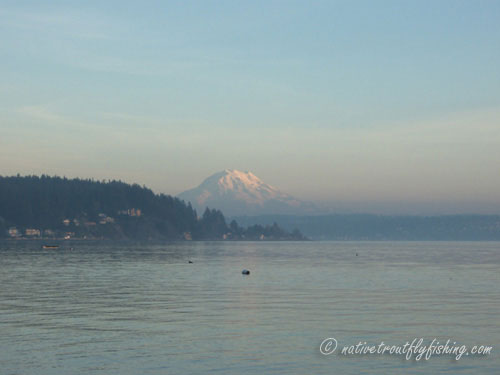Fly Fishing the Puget Sound
Along with the great fishing found in Puget Sound, there are also great views of Mount Rainier, the Cascades and the Olympic Mountains from many beaches.
Introduction
Although it escaped the attention of fly fisherman for many years, the Puget Sound affords some excellent fishing and is a resource that many fly anglers are finally beginning to discover and explore. On this page I will cover some of the basics of fly fishing in the Puget Sound. The main concentration for this article will be the Puget Sound South of Seattle, as this is the area that I fish most often and have the highest level of familiarity with. However many of the basic principles will carry over to the Northern part of the Sound as well. This is by no means a comprehensive review on the fishing in the Puget Sound, as that could easy fill several books, but instead a basic overview.
The Puget Sound basin south of Seattle is not overly blessed with good fly fishing rivers, but what it lacks in freshwater fishing opportunities, it more than makes up for in what is offered by the salt water. The area is fed by countless small streams that provide spawning areas for anadromous salmon and trout and once these trout and salmon enter the salt water they grow very quickly and make for great sport on a fly rod. Anglers that are willing to explore and experiment will find nearly endless opportunities, which get even better with access to a boat. Wading is an extremely effective way to fish the Sound, but anglers should be aware of the tides as they can leave a wading angler in a world of trouble if you get caught at the wrong place on a rising tide.
Fishing around the tides is also major part of being successful on the Sound. Every beach tends to fish a little differently, with some producing better fishing on an incoming tide and others on an outgoing. Typically larger tidal flows produce more fish than small ones, and I have found that the fishing is generally better during fast moving outgoings and slower moving incomings. Fish tend to congregate in areas that receive a good tidal current so points and areas where the tidal flow is constricted are good spots to look for fish. Slack tide is typically the worst time to fish, but the exception to this occurs when fishing for Chinook salmon, which is typically best from one hour before to one hour after slack tide. Time of the day may be an important concern as well, especially for salmon which often bite better early in the morning or in the evening.
When fishing the Puget Sound I would suggest having at least two different rods, a lighter five or six weight for cutthroat and resident coho and a heavier seven to nine weight rod for returning salmon. Reels are really a choice of the angler, but I find that especially for returning salmon it is best to have a reel with a good drag system. This last year I had a reel that was completely worn out after a few days of great fishing for chum and coho salmon off of a local estuary so buying a well built reel is also a good idea. It is also important to remember that your gear is going to be exposed to salt water and as such reels should be kept well greased. After each outing it is also a good idea to wash off all of your gear with freshwater to prevent corrosion.
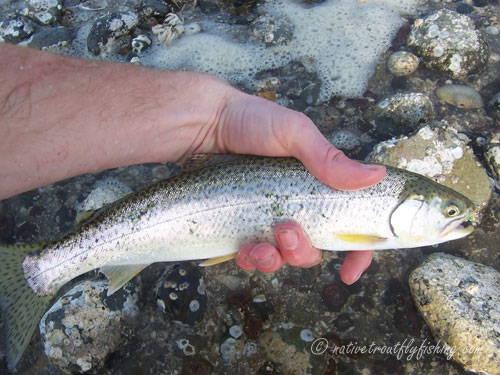
A coastal cutthroat caught on a marabou clouser minnow
Coastal Cutthroat: Mainstay of the Puget Sound fly angler
Coastal cutthroat in the Puget Sound are all native fish and are available to some degree year round making the main target of most fly anglers on the Sound. Cutthroat can generally be found along shorelines with eel grass, oyster beds or rocky bottoms within several miles of a stream mouth. Places with boulders, points, current rips or back eddies are also productive places to search for these fish. One feature of coastal cutthroat that makes them especially appealing to fly anglers is that are typically found fairly close to shore and are usually well within the reach of shore bound fisherman. The best time of the year to fish for cutthroat is from early Spring through Fall, with the months of September and October typically producing some of the best fishing of the year.
Cutthroat generally are not very picky and if I had to choose one fly for fishing the South Sound it would be a marabou clouser minnow. However at times they do become very selective and difficult to catch. As such it is a good idea to have a variety of patterns to imitate the various prey items available to cutthroat throughout the year. Any serious salt water cutthroat angler should carry patterns to imitate baitfish like sand lance, herring, sculpin, and seasonally salmon fry, as well as saltwater worms, shrimp, amphipods and eusphausids. Beyond using subsurface patterns, dry flies and poppers or gurglers can be very effective for cutthroat as well. However surface will more often than not have a low hit to hook up ratio and a great tactic for these fish is use a surface fly to locate were they are holding, than to switch to a subsurface pattern after you found them. For their size, coastal cutthroat in the saltwater fight better than just about any other fish, although they usually do not put on as much of an aerial display as other species of fish do. The average size of these fish tends to between 10 and 14 inches, but there are a fair number of larger fish out there with some over 20 inches available. Since the cutthroat fishery was changed to catch and release only in the mid 90's, the number and size of the fish has improved dramatically. For more information on the life history and diet of these trout, please see the following page on coastal cutthroat.
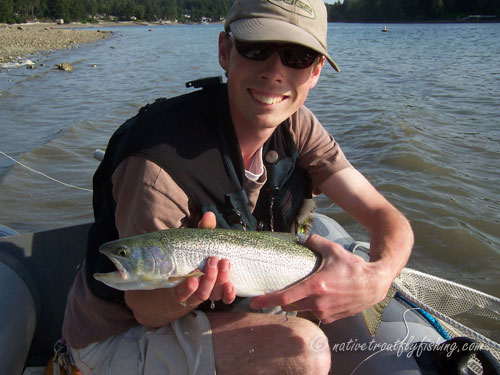
Big cutthroat are definitely around for those willing to look.
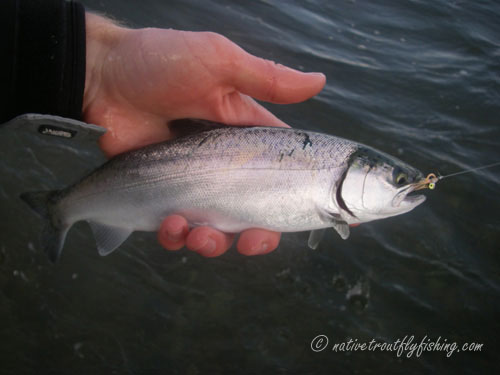
A typical resident coho salmon from the South Sound
Resident Coho
Another great option around the South Sound is fishing for resident coho salmon, which usually have an average size of between 14" and 16" during the Winter months. These fish are often found within easy casting distance of shore and will typically give their position away by jumping. When you hit it right for these fish, they can provide some outstanding fishing. There are generally two different strategies that I employ when fishing for resident coho, with one being picking a productive spot and allowing the fish to come to you. The other is going to where the fish are and is best employed when the fish are scattered. I personally find the second method to be much more fun and effective under normal conditions. Usually this calls for walking the beach until you find some jumping fish. Once you have located the fish the key is determining the direction that they are traveling in and getting in front of them. With the average school you will get a chance at a couple of fish before the school moves on and you have to chase it down again. With this method you will typically end up covering a lot ground, but may end up finding a stationary school, which usually means that you are in for some excellent fishing. Typically resident coho are not very picky and attractor patterns like clouser minnows, snot darts, crazy Charlies or even gurglers work great. When you do run into resident coho that are feeding selectively, changing fly colors or patterns until you find what they are feeding on is key. During the Winter when this happens more often than not they will be keyed in on amphipods or eusphausids and a lighter colored fly is required to get the fish to bite. Fishing for resident coho tends to be best in the Winter and early Spring, but they can be found anytime of the year. By July these fish will typically reach a size of two to six pounds and although they are not as numerous as during the Winter fishing can still be very good. For more information on the life history and diet of these trout, please see the following page on coho salmon.
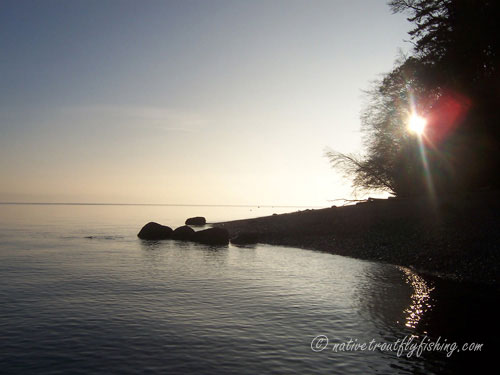
A foggy day at a beach with prime resident coho and cutthroat structure. Note the point, rocks and angle of the beach.
Migratory salmon and other fish
Starting in the middle of Summer and continuing through the end of Fall, migratory salmon return from their oceanic wanderings to spawn in their natal streams. As they near their home streams, these fish often travel close to shore or stage off of estuaries where they can be intercepted by shore bound fly anglers. Although all five species of Pacific salmon pass through the Puget Sound, sockeye and Chinook salmon prove to be very difficult targets and are not as commonly caught. Fly fisherman may have better shots at getting into Chinook salmon during low light conditions early or late in the day or when it is cloudy out. On odd years pink salmon return to the larger rivers around the Puget Sound in substantial numbers and by August provide excellent fishing. Points are the best places to look for these fish and as their name suggests pink flies work best. These fish are extremely aggressive and tend to be much more willing to hit flies than the other species Pacific salmon.
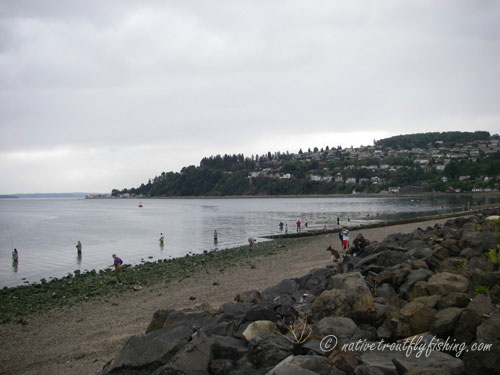
When the salmon return, normally uncrowded beaches can turn into combat fisheries. Here is the scene at Brown's Point during the pink salmon run.
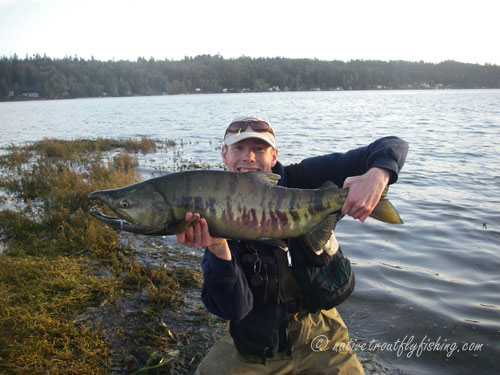
Chum salmon provide a true big fish experience, here is me with a 20lb fish from a local estuary.
By the end of August coho begin to show up in fishable numbers and can quite aggressive towards flies at times. Baitfish and shrimp patterns are the best choice for fresh fish, but for fish that have been in the Sound for a while and are nearing their spawning streams small attractors may work better. Fishing for these coho that are nearing their natal stream can be quite frustrating as these fish have a tendency to get a bit "lock jawed." The average coho is around eight pounds, and will put a serious bend in a fly rod making an eight weight rod the best choice. It is not uncommon to have coho grab the same fly that you are using for cutthroat, as the two types of fish both have similar habitat preference. Productive structure for coho includes current rips, points and kelp beds. As the coho begin to trail off, chum salmon fishing picks up off of the estuaries around the Sound. These fish may reach weights in excess of twenty pounds and provide a great opportunity at a truly large fish. Flies in chartreuse, pink, purple, and black all produce fish.
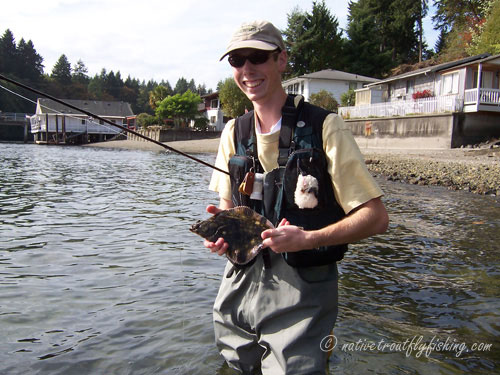
Part of the fun of fishing on the Puget Sound is that you never know what you are going to catch, such as this flounder that I caught while fishing for cutthroat.
Non-salmonids are encountered from time to time while fishing the Sound as well and some of these fish can provide excellent sport on a fly rod. Flounder inhabit many of the same beaches where cutthroat and salmon are found and by simply slowing down the speed at which the fly is retrieved anglers can find themselves catching their fair share of these fish. Pile perch are another popular fish with anglers. These fish can be found around docks and pilings and will generally respond well to worm patterns or snot darts.
The Puget Sound provides anglers a unique fishery and a real chance at a true big fish experience. No matter the time of the year, there is always something available and for those anglers like me who enjoy fly fishing for native salmonids the Puget Sound has an extra appeal with its native cutthroat and five species of salmon, making it well worth checking out.
Suggested Books
Fly Fishing for Coastal Cutthroat by Les Johnson, The Estuary Fly Fisher by Steve Raymond and Fly Fishing for Pacific Salmon II by Les Johnson and Bruce Ferguson
Contact
Feel free to contact me if you have any questions or comments
Native Trout Links
California Heritage Trout Challenge
Truchas Mexicanas' - Native Trout of Mexico
Balkan Trout Restoration Group
Trout and Seasons of the Mountain Village - About Japanese Trout
Fly Fishing Blogs
Dave B's Blog: Fly Fishing for Native Trout
The Search for Native Salmonids
Conservation Links
Western Native Trout Initiative
Fly Fishing Links
Fishing Art Links
Americanfishes.com - Joseph R. Tomelleri
Fish Eye Guy - Underwater Trout and Salmon Pictures
